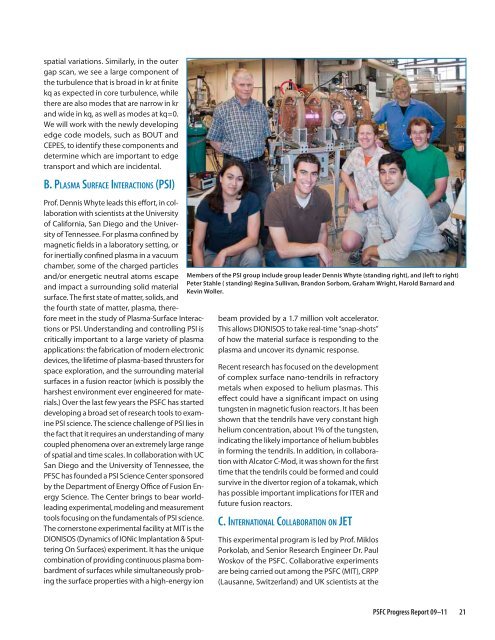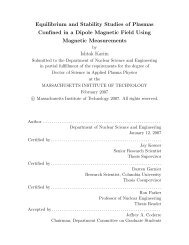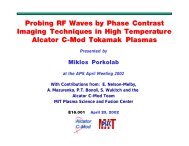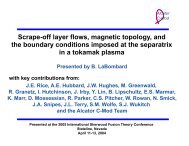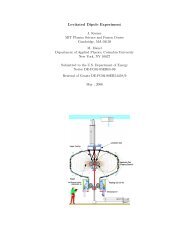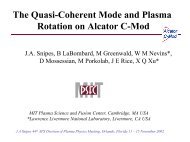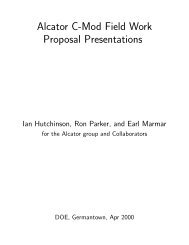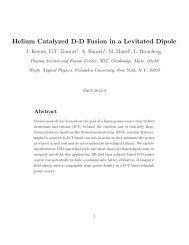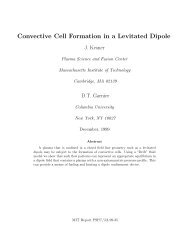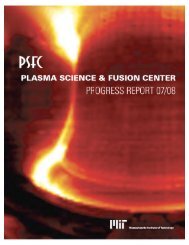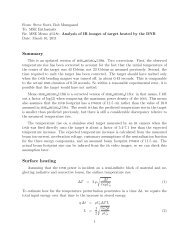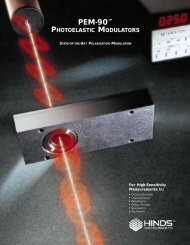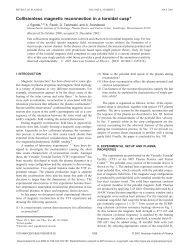Download a copy of the latest PSFC Progress Report - Plasma ...
Download a copy of the latest PSFC Progress Report - Plasma ...
Download a copy of the latest PSFC Progress Report - Plasma ...
You also want an ePaper? Increase the reach of your titles
YUMPU automatically turns print PDFs into web optimized ePapers that Google loves.
spatial variations. Similarly, in <strong>the</strong> outer<br />
gap scan, we see a large component <strong>of</strong><br />
<strong>the</strong> turbulence that is broad in kr at finite<br />
kq as expected in core turbulence, while<br />
<strong>the</strong>re are also modes that are narrow in kr<br />
and wide in kq, as well as modes at kq=0.<br />
We will work with <strong>the</strong> newly developing<br />
edge code models, such as BOUT and<br />
CEPES, to identify <strong>the</strong>se components and<br />
determine which are important to edge<br />
transport and which are incidental.<br />
B. <strong>Plasma</strong> Surface Interactions (PSI)<br />
Pr<strong>of</strong>. Dennis Whyte leads this effort, in collaboration<br />
with scientists at <strong>the</strong> University<br />
<strong>of</strong> California, San Diego and <strong>the</strong> University<br />
<strong>of</strong> Tennessee. For plasma confined by<br />
magnetic fields in a laboratory setting, or<br />
for inertially confined plasma in a vacuum<br />
chamber, some <strong>of</strong> <strong>the</strong> charged particles<br />
and/or energetic neutral atoms escape<br />
and impact a surrounding solid material<br />
surface. The first state <strong>of</strong> matter, solids, and<br />
<strong>the</strong> fourth state <strong>of</strong> matter, plasma, <strong>the</strong>refore<br />
meet in <strong>the</strong> study <strong>of</strong> <strong>Plasma</strong>-Surface Interactions<br />
or PSI. Understanding and controlling PSI is<br />
critically important to a large variety <strong>of</strong> plasma<br />
applications: <strong>the</strong> fabrication <strong>of</strong> modern electronic<br />
devices, <strong>the</strong> lifetime <strong>of</strong> plasma-based thrusters for<br />
space exploration, and <strong>the</strong> surrounding material<br />
surfaces in a fusion reactor (which is possibly <strong>the</strong><br />
harshest environment ever engineered for materials.)<br />
Over <strong>the</strong> last few years <strong>the</strong> <strong>PSFC</strong> has started<br />
developing a broad set <strong>of</strong> research tools to examine<br />
PSI science. The science challenge <strong>of</strong> PSI lies in<br />
<strong>the</strong> fact that it requires an understanding <strong>of</strong> many<br />
coupled phenomena over an extremely large range<br />
<strong>of</strong> spatial and time scales. In collaboration with UC<br />
San Diego and <strong>the</strong> University <strong>of</strong> Tennessee, <strong>the</strong><br />
PFSC has founded a PSI Science Center sponsored<br />
by <strong>the</strong> Department <strong>of</strong> Energy Office <strong>of</strong> Fusion Energy<br />
Science. The Center brings to bear worldleading<br />
experimental, modeling and measurement<br />
tools focusing on <strong>the</strong> fundamentals <strong>of</strong> PSI science.<br />
The cornerstone experimental facility at MIT is <strong>the</strong><br />
DIONISOS (Dynamics <strong>of</strong> IONic Implantation & Sputtering<br />
On Surfaces) experiment. It has <strong>the</strong> unique<br />
combination <strong>of</strong> providing continuous plasma bombardment<br />
<strong>of</strong> surfaces while simultaneously probing<br />
<strong>the</strong> surface properties with a high-energy ion<br />
Members <strong>of</strong> <strong>the</strong> PSI group include group leader Dennis Whyte (standing right), and (left to right)<br />
Peter Stahle ( standing) Regina Sullivan, Brandon Sorbom, Graham Wright, Harold Barnard and<br />
Kevin Woller.<br />
beam provided by a 1.7 million volt accelerator.<br />
This allows DIONISOS to take real-time “snap-shots”<br />
<strong>of</strong> how <strong>the</strong> material surface is responding to <strong>the</strong><br />
plasma and uncover its dynamic response.<br />
Recent research has focused on <strong>the</strong> development<br />
<strong>of</strong> complex surface nano-tendrils in refractory<br />
metals when exposed to helium plasmas. This<br />
effect could have a significant impact on using<br />
tungsten in magnetic fusion reactors. It has been<br />
shown that <strong>the</strong> tendrils have very constant high<br />
helium concentration, about 1% <strong>of</strong> <strong>the</strong> tungsten,<br />
indicating <strong>the</strong> likely importance <strong>of</strong> helium bubbles<br />
in forming <strong>the</strong> tendrils. In addition, in collaboration<br />
with Alcator C-Mod, it was shown for <strong>the</strong> first<br />
time that <strong>the</strong> tendrils could be formed and could<br />
survive in <strong>the</strong> divertor region <strong>of</strong> a tokamak, which<br />
has possible important implications for ITER and<br />
future fusion reactors.<br />
C. International Collaboration on JET<br />
This experimental program is led by Pr<strong>of</strong>. Miklos<br />
Porkolab, and Senior Research Engineer Dr. Paul<br />
Woskov <strong>of</strong> <strong>the</strong> <strong>PSFC</strong>. Collaborative experiments<br />
are being carried out among <strong>the</strong> <strong>PSFC</strong> (MIT), CRPP<br />
(Lausanne, Switzerland) and UK scientists at <strong>the</strong><br />
<strong>PSFC</strong> <strong>Progress</strong> <strong>Report</strong> 09–11 21


